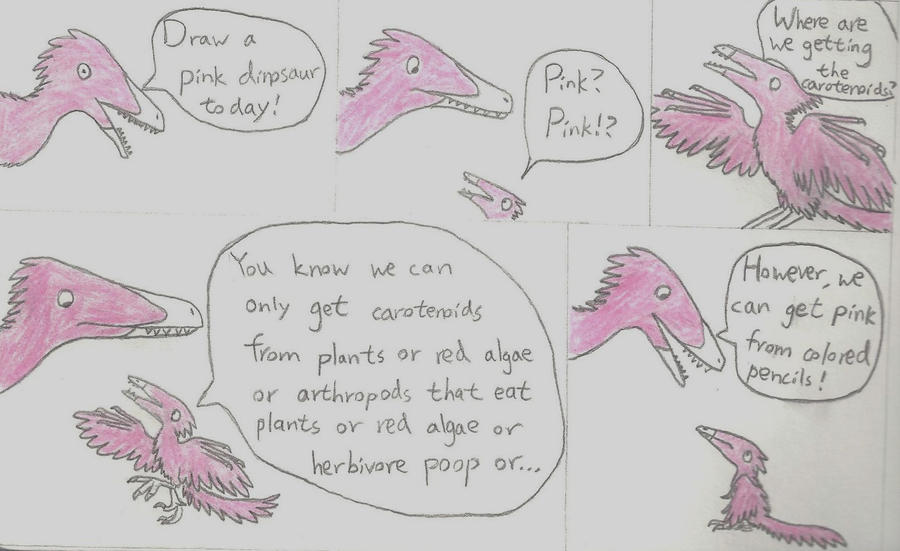
Traditionally, dino artists have always been free to take liberties with dinosaur colors. After all, just about all of our dinosaur books make a point of how it's impossible to tell colors from dinosaur fossils. However, that's beginning to change. Thanks to exciting new developments in the examination of fossils, it is now possible to identify some types of color pigments in fossilized integument. So it is very possible that many of our speculations on dinosaur colors, particularly of those that have their skin and skin coverings preserved with them, will be proven wrong.
But we are still allowed to take liberties with prehistoric beasts that haven't or won't have their colors revealed, right?
Well, not exactly, especially concerning feathered dinosaurs like maniraptors.
There are several ways feathers get their colors. Blue is the result of light being scattered through microscopic structures within integument. The pennaceous feathers* of deinonychosaurs and oviraptorosaurs certainly have the potential to be blue, but we're not so sure about protofeathers. Superficially, protofeathers look a lot like mammalian hair, which cannot be blue. (Which explains why there are mammals with blue skin but not blue fur, even in groups that have fairly good color vision.) And fossilized iridescent feathers usually restrict their iridescence to the barbules, which protofeathers don't have. However, protofeathers, being homologous to pennaceous feathers, had an internal structure more like pennaceous feathers than like hair. So blue protofeathers might still be possible.
*Deinonychosaurs, oviraptorosaurs, and basal birds have pennaceous feathers only on the wings and tail, or (in deinonychosaurs at least) occasionally on the head and parts of the body, the rest of the body being covered in protofeathers. For a more detailed description of feather distribution in the derived maniraptors, see here.
Most other colors are produced through color pigments. Melanins are responsible for different shades of gray and brown, and a lack of melanin will result in white. Combined with structural color, melanins can also produce full-on black. So far, fossilized dinosaur colors have been deduced by examining their preserved melanin pigments.
Another group of pigments is the carotenoids. These are responsible for bright reds, yellows, and oranges in not only feathers but skin, yolk*, and scales. They can also combine with structural color to make green. Dinosaurs can't make carotenoids by themselves. They must eat plants, or fish and invertebrates that eat plants. Because of this, carnivorous dinosaurs don't have much choice in feather colors and generally make do with just structural colors and melanins, unless they feed on herbivorous fish or insects. (Duller reds are okay for carnivores though, as they can be produced by melanins.) There are exceptions to this, like Egyptian vultures which have bright yellow faces, but that's because they feed on herbivore poop.
*Many birds use flavins for yolk instead.
There are also the porphyrins, which probably don't fossilize, but luckily the colors they produce (mostly browns and reds) can probably be deduced through just melanin. Interestingly, they have a role in insulation, so perhaps feathered dinosaurs that were active in colder temperatures had a few extra splashes of reddish brown. There are other types of color pigments out there, and many bird groups have evolved their own unique pigments, but these are the main ones.
For a much more comprehensive and detailed guide, go to DinoGoss!
Now, how did an announcement about a fundraising event turn into this?







"Now, how did an announcement about a fundraising event turn into this?"
ReplyDeleteI don't know, but I'm glad it did! Lots of non-avian dinosaur feather stuff going on lately, both research, and blogging. Awesome.
I don't know either, but you've just written the most fantastic and easy-to-understand explanation of feather colors I have read. (Plus a wikkid cute comic.) Thanks!
ReplyDelete